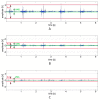Effects of Immobilization and Re-Mobilization on Knee Joint Arthrokinematic Motion Quality
- PMID: 32041248
- PMCID: PMC7074294
- DOI: 10.3390/jcm9020451
Effects of Immobilization and Re-Mobilization on Knee Joint Arthrokinematic Motion Quality
Abstract
Background: Knee immobilization is a common intervention for patients with traumatic injuries. However, it usually leads to biomechanical/morphological disturbances of articular tissues. These changes may contribute to declining kinetic friction-related quality of arthrokinematics; however, this phenomenon has not been analyzed in vivo and remains unrecognized. Thus, the aim of the present study is to investigate the effect of immobilization and subsequent re-mobilization on the quality of arthrokinematics within the patellofemoral joint, analyzed by vibroarthrography (VAG).
Methods: Thirty-four patients after 6-weeks of knee immobilization and 37 controls were analyzed. The (VAG) signals were collected during knee flexion/extension using an accelerometer. Patients were tested on the first and last day of the 2-week rehabilitation program.
Results: Immobilized knees were characterized by significantly higher values of all VAG parameters when compared to controls (p < 0.001) on the first day. After 2 weeks, the participants in the rehabilitation program that had immobilized knees showed significant improvement in all measurements compared to the baseline condition, p < 0.05. However, patients did not return to normal VAG parameters compared to controls.
Conclusion: Immobilization-related changes within the knee cause impairments of arthrokinematic function reflected in VAG signal patterns. The alterations in joint motion after 6 weeks of immobilization may be partially reversible; however, the 2-week physiotherapy program is not sufficient for full recovery.
Keywords: arthrokinematics; cartilage; crepitus; immobilization; re-mobilization; synovial joint.
Conflict of interest statement
The authors declare no conflict of interest.
Figures


Similar articles
-
Effects of Viscosupplementation on Quality of Knee Joint Arthrokinematic Motion Analyzed by Vibroarthrography.Cartilage. 2021 Oct;12(4):438-447. doi: 10.1177/1947603519847737. Epub 2019 May 9. Cartilage. 2021. PMID: 31072141 Free PMC article.
-
Analysis of patellofemoral arthrokinematic motion quality in open and closed kinetic chains using vibroarthrography.BMC Musculoskelet Disord. 2019 Jan 31;20(1):48. doi: 10.1186/s12891-019-2429-z. BMC Musculoskelet Disord. 2019. PMID: 30704430 Free PMC article.
-
Using Nonlinear Vibroartrographic Parameters for Age-Related Changes Assessment in Knee Arthrokinematics.Sensors (Basel). 2022 Jul 25;22(15):5549. doi: 10.3390/s22155549. Sensors (Basel). 2022. PMID: 35898052 Free PMC article.
-
Vibroarthrographic analysis of patellofemoral joint arthrokinematics during squats with increasing external loads.BMC Sports Sci Med Rehabil. 2020 Aug 27;12:51. doi: 10.1186/s13102-020-00201-z. eCollection 2020. BMC Sports Sci Med Rehabil. 2020. PMID: 32874592 Free PMC article.
-
The science of anterior cruciate ligament rehabilitation.Clin Orthop Relat Res. 2002 Sep;(402):9-20. doi: 10.1097/00003086-200209000-00003. Clin Orthop Relat Res. 2002. PMID: 12218469 Review.
Cited by
-
Age-Related Differences in Intermuscular Coherence EMG-EMG of Ankle Joint Antagonist Muscle Activity during Maximal Leaning.Sensors (Basel). 2022 Oct 4;22(19):7527. doi: 10.3390/s22197527. Sensors (Basel). 2022. PMID: 36236626 Free PMC article.
-
Long-term locked knee ankle foot orthosis use: A perspective overview of iatrogenic biomechanical and physiological perils.Front Rehabil Sci. 2023 May 4;4:1138792. doi: 10.3389/fresc.2023.1138792. eCollection 2023. Front Rehabil Sci. 2023. PMID: 37214128 Free PMC article.
-
Gonarthrosis related changes in quadriceps muscle architecture and physical function outcomes in women.Sci Rep. 2025 Mar 25;15(1):10282. doi: 10.1038/s41598-025-89677-8. Sci Rep. 2025. PMID: 40133373 Free PMC article.
-
Acute effects of a single bout of exercise therapy on knee acoustic emissions in patients with osteoarthritis: a double-blinded, randomized controlled crossover trial.BMC Musculoskelet Disord. 2022 Jul 11;23(1):657. doi: 10.1186/s12891-022-05616-y. BMC Musculoskelet Disord. 2022. PMID: 35820904 Free PMC article. Clinical Trial.
-
The Structural Adaptations That Mediate Disuse-Induced Atrophy of Skeletal Muscle.Cells. 2023 Dec 10;12(24):2811. doi: 10.3390/cells12242811. Cells. 2023. PMID: 38132132 Free PMC article. Review.
References
-
- Jiang S., He R., Zhu L., Liang T., Wang Z., Lu Y., Ren J., Yi X., Xiao D., Wang K. Endoplasmic reticulum stress-dependent ROS production mediates synovial myofibroblastic differentiation in the immobilization-induced rat knee joint contracture model. Exp. Cell Res. 2018;369:325–334. doi: 10.1016/j.yexcr.2018.05.036. - DOI - PubMed
LinkOut - more resources
Full Text Sources

